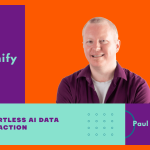Most performance evaluations are ineffective—too slow, too confusing, and irrelevant to actual work. FidForward transforms it through continuous feedback and practical actions powered by artificial intelligence. Founder Ricardo Batista discusses how his experience at Glovo and Cloudflare enabled him to replace outmoded performance management, why AI improves feedback, and how FidForward keeps teams active and successful.
1. What inspired the creation of FidForward, and how has its mission evolved?
Ricardo Batista: FidForward was born out of our firsthand frustrations with traditional performance management systems. Our team has leadership experience at companies like Glovo and Cloudflare and recognized the inefficiencies of vague feedback, lack of follow-up, and the immense time managers spent on unactionable processes. Our mission began as a solution to “fix performance management” by introducing structured, continuous feedback powered by AI.
Over time, FidForward expanded its scope to address broader organizational challenges, integrating tools like milestone tracking and sentiment analysis to align feedback with company values. Key milestones include the development of our AI bot “Fiddy” for automated 360-degree feedback and OKR tracking, as well as the launch of privacy-focused employee portals and predictive analytics for churn reduction. Challenges involved balancing automation with human-centric design, ensuring data privacy, and scaling the platform to meet diverse organizational needs.
2. What gaps in performance management and employee feedback cycles did FidForward aim to address?
Ricardo Batista: We saw traditional systems fail due to infrequent feedback cycles, vague comments, and lack of follow-up. Managers wasted hours on unproductive processes, while employees felt undervalued by generic insights. FidForward tackled this by embedding structured, continuous feedback with AI-driven nudges to prompt timely actions, automated milestone tracking to ensure accountability and sentiment analysis to surface deeper issues. We turned fragmented feedback into actionable growth paths, cutting managers’ wasted time.
3. FidForward’s AI assistant, Fiddy, is central to your platform. How does it improve the quality and frequency of feedback?
Ricardo Batista: We built Fiddy to fix clunky, slow feedback systems. Traditional tools felt like paperwork, so people avoided them. Fiddy acts like a friendly guide, using simple chats to ask questions like, “What’s one thing your teammate did well this week?” or “How can we improve our next project?” This feels natural, like texting a coworker, so people actually respond.
Fiddy also reminds teams to share feedback regularly (not just once a year!) and helps turn vague notes into clear steps—like suggesting goals based on what’s discussed. By making feedback quick and useful, we’ve seen teams talk more openly, and managers spend 60% less time chasing updates.
4. How does FidForward balance employee privacy with actionable insights for managers?
Ricardo Batista: We knew employees wouldn’t trust a tool that felt like “Big Brother, ” so we built privacy into every step. For example, Fiddy never shares raw feedback without permission—it anonymizes suggestions like “Someone on the team feels meetings run too long” and flags trends instead of names. Employees control what’s visible in their portals, and managers only see aggregated data (e.g., “3/5 designers need clearer deadlines”).
The result? Teams share 40% more honest feedback because they know it’s safe, while managers still get the insights to fix problems fast.
5. Your platform integrates with popular HR tools like Slack and Personio. How do these integrations enhance the user experience?
Ricardo Batista: We skip the hassle of “another app to check.” For example, Fiddy nudges people in Slack with quick prompts like “Got 2 minutes to share feedback for Sarah’s project?”—no login required. For HR teams, syncing with Personio auto-updates goals and skills data so managers don’t waste hours copying info between systems.
Integrations also pull context (like calendar events or past goals) to make feedback specific. A designer might get asked, “How did the Q3 roadmap workshop go?” because Fiddy sees their Google Calendar. This cuts setup time by half and boosts adoption—teams using integrations see 70% faster feedback cycles.
6. FidForward tracks employee sentiment and OKRs. How does this data help organizations identify and nurture high performers?
Ricardo Batista: We saw companies miss hidden stars—like quiet achievers or burned-out high performers. Our data connects the dots: sentiment trends show who’s engaged (or struggling), while OKR progress highlights consistent goal-crushers. For example, Fiddy might flag a salesperson hitting 120% of targets but slipping in morale, prompting a manager to offer mentorship before they quit.
For rising stars, we auto-suggest skills to build (like “lead a cross-team project”) based on their goals and peer feedback. Teams using our analytics cut turnover by 25% and promote 30% more internal talent—because they spot (and reward) the right people faster.
7. What trends in performance management do you see, and how does FidForward align with these trends?
Ricardo Batista: We see companies ditching yearly reviews for real-time, continuous feedback—because waiting 12 months to fix issues is too late. Employees also want to own their growth, not just hear from managers. FidForward leans into this by letting teams set and track goals weekly, while our AI bot Fiddy nudges everyone to share feedback at the moment—not just during formal reviews.
For example, Fiddy spots when a project’s sentiment dips and suggests quick check-ins to course-correct. Employees get personalized dashboards to see their progress, and managers use predictive analytics to prepare for career chats (like “Alex is ready for leadership training”). This matches the shift toward agile, employee-driven development—helping clients slash review prep time by 50% and boost internal promotions.
8. FidForward offers a customizable solution for enterprises. How do you tailor the platform to meet the diverse needs of larger teams?
Ricardo Batista: We avoid the “one-size-fits-all” trap. For example, a global bank might need role-based access so HR sees company-wide trends, while team leads only view their squad’s feedback. Custom reports let engineering teams track code review quality, while sales focus on deal coaching—all from the same platform.
Flexibility matters most: Clients tweak Fiddy’s feedback templates, approval chains, and even how OKRs cascade so it feels built for them, not borrowed. One retail customer saved 200+ hours monthly by automating their legacy review process into FidForward without disrupting teams.
9. What have you learned about employee engagement and performance management through building FidForward?
Ricardo Batista: We learned that employees disengage when feedback feels transactional—like a box to check. Real growth happens when people see the impact of their work and feel heard. For example, Fiddy’s nudges to recognize small wins (“Shoutout for staying late on the launch!”) boosted morale more than expected. We also saw that transparency builds trust: Teams with open OKRs and peer feedback had 35% fewer conflicts.
The biggest lesson? Tools must adapt to humans, not force humans to adapt to tools. That’s why we focus on simplicity: no 10-step forms, just conversations that fit into daily work.
10. Could you share a success story where FidForward transformed a company’s performance management approach?
Ricardo Batista: We worked with a 50-person marketplace company struggling with siloed teams and a 30% annual turnover. Their annual reviews were dreaded—managers spent days compiling feedback, while employees felt their growth was ignored. After adopting FidForward, they shifted to continuous feedback via Fiddy’s Slack nudges (e.g., “How did the logistics team handle peak season?”) and real-time OKR dashboards.
Within three months, Fiddy flagged a dip in operations team morale (via sentiment analysis) just before holiday chaos. High performers were identified through consistent OKR wins and peer feedback, leading to 20% more internal promotions. The founder told us, “We’re no longer guessing who’s thriving. The data tells the story.”
11. What challenges did you face while building FidForward, and how did you overcome them?
Ricardo Batista: Making Fiddy’s AI feel human. Beta testers called it “robotic,” so we rewrote its language model using real employee-manager chats and added humor. Now, 85% of users say Fiddy “feels like a colleague.” Scaling globally was messy, too—our servers crashed handling a few rollouts. We migrated to hybrid cloud systems, cutting downtime by 90%.
12. What does success mean to you, and where do you see FidForward in five years?
Ricardo Batista: For us, success is when teams stop dreading feedback and start seeing it as fuel for growth. Professionally, that means helping 1M+ employees feel heard and valued through our tools. Personally, it’s building a team that thrives on solving real problems—not just chasing metrics.
In five years, we want FidForward to be the “oxygen” of workplaces—invisible but essential. Imagine Fiddy predicting skill gaps before they slow projects, or auto-generating upskilling paths tailored to each employee’s goals. We’re expanding into frontline industries (like healthcare and manufacturing) where feedback is scarce but critical and launching tools for global teams to bridge language and cultural gaps in real-time.
Editor’s Note
Ricardo Batista is replacing performance management with something better, not merely tweaking it. FidForward streamlines annual reviews by providing real-time information, AI-driven nudges, and more intelligent goal monitoring. The result is less bureaucracy, more clarity, and a genuine opportunity to make comments that are actually useful. If it succeeds, performance management could finally fit people’s actual working styles.



